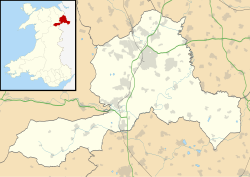RAF Wrexham
| RAF Wrexham | |
|---|---|
| Located in Borras, Wrexham | |
 |
|
| Coordinates | 53°04′00″N 2°57′01″W / 53.0668°N 2.9504°W |
| Type | Military Airfield |
| Site information | |
| Controlled by | Royal Air Force |
| Condition | Land re-used as quarry. Royal Observer Corps nuclear bunker in use as a recording studio. |
| Site history | |
| Built | 1917 (first use) |
| Built by | Royal Flying Corps |
| In use | 1917-1920 1940-1945 1962-1992 |
| Demolished | 1970s |
| Battles/wars |
Battle of Britain Defence of Liverpool Cold War |
| Garrison information | |
| Garrison |
No. 285 Squadron RAF (1941–1944) No. 96 Squadron RAF (1941–1942) RAF. 21 Grp. AFU 1944-1945 HQ 17 Group Royal Observer Corps (North Wales) 1962 - 1992 |
RAF Wrexham was a Royal Air Force station at Borras, on the outskirts of Wrexham, Wales and east of the town centre.
Initially opened as a municipal aerodrome the airfield was used by the Royal Flying Corps during World War I and the Royal Air Force in World War II. The airfield became the site of a Royal Observer Corps nuclear bunker during the Cold War.
The first noted involvement of aviation with Wrexham was in 1912 when Gustav Hamel visited the Racecourse Ground to entertain the public with air displays. The local council discussed transforming the racecourse into a municipal airport.
During the period 1917 - 1920 fields at Borras Lodge were used by Nos. 4 and 51 Training Squadrons/Schools of the Royal Flying Corps and after 1918 by Royal Air Force training squadrons based at RAF Shotwick (later RAF Sealand) and Hooton Park. The same location was also used by the Lancashire Aero Club and the Liverpool and District Aero Club for air displays during the 1930s, and two visits from Sir Alan Cobham's National Aviation day Circus.
As the entire area was on a plateau, the field was largely dry, unlike RAF Sealand and Hawarden Airport, both reclaimed from the River Dee. This dryness encouraged visits from several training squadrons, such as spitfires from RAF Ternhill. After the initial breakout of the War, No 5 Service Flying Training School used the ground as a relief strip, and in 1940, three grass runways of approximately 550-660 yards existed. The wet conditions of surrounding airfields usually caused training groups to send planes to Wrexham, which had no air traffic control, which caused several incidents.
The main period of construction at the site took place between December 1940 and June 1941, which often saw floodlit operations during the dark winter. The airfield was upgraded with hardened concrete runways and appropriate lighting for them, with defence against any possible ground invasion provided by the ring of defences surrounding the nearby Royal Ordnance Factory. The Airfield was primarily built to house a night fighter squadron for the air defence of Liverpool and Manchester, and in 1941, No. 96 Squadron RAF, a night fighter squadron, was moved to Wrexham from RAF Cranage. In 1944 it was occupied by RAF. 21 Grp. AFU.
...
Wikipedia

